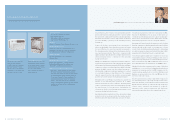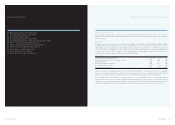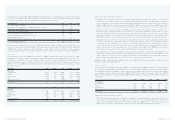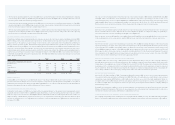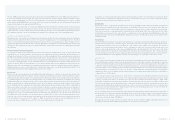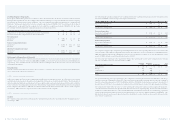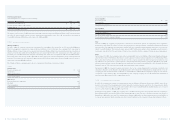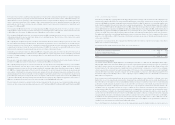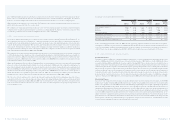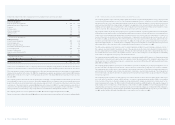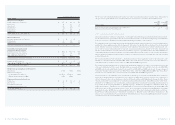Whirlpool 2002 Annual Report Download - page 25
Download and view the complete annual report
Please find page 25 of the 2002 Whirlpool annual report below. You can navigate through the pages in the report by either clicking on the pages listed below, or by using the keyword search tool below to find specific information within the annual report.
2002 Annual Report 47
Notes to Consolidated Financial Statements
46
Notes to Consolidated Financial Statements
>01 SUMMARY OF PRINCIPAL ACCOUNTING POLICIES
Nature of Operations
Whirlpool Corporation is the world’s leading manufacturer and marketer of major home appliances. The company
manufactures in nine countries under nine major brand names and markets products to distributors and retailers in
more than 170 countries.
Principles of Consolidation
The consolidated financial statements include all majority-owned subsidiaries. Investments in affiliated companies,
consisting principally of direct voting interests of 40% and 49% in two other international companies principally
engaged in the manufacture and sale of major home appliances or related component parts, are accounted for by the
equity method. All intercompany transactions have been eliminated upon consolidation.
Use of Estimates
Management is required to make estimates and assumptions that affect the amounts reported in the financial
statements and accompanying notes. Actual results could differ from those estimates.
Revenue Recognition
Sales are recorded when title passes to the customer. The point at which title passes is determined by the shipping
terms, which generally designate a transfer of title to the customer as soon as the product is shipped. Allowances for
estimated returns are made on sales of certain products based on historical return rates for the products involved.
Accounts Receivable and Allowance for Doubtful Accounts
The company carries its accounts receivable at their face amounts less an allowance for doubtful accounts. On a
periodic basis, the company evaluates its accounts receivable and establishes the allowance for doubtful accounts
based on a combination of specific customer circumstances and credit conditions and based on a history of write-offs
and collections. The company’s policy is to generally not charge interest on trade receivables after the invoice
becomes past due. A receivable is considered past due if payments have not been received within agreed upon invoice terms.
Freight and Warehousing Costs
Freight-out and warehousing costs included in selling, general and administrative expenses in the statements of
operations were $520 million, $497 million and $470 million in 2002, 2001 and 2000, respectively.
Cash and Equivalents
All highly liquid debt instruments purchased with a maturity of three months or less are considered cash equivalents.
Inventories
Inventories are stated at first-in, first-out (FIFO) cost, except U.S. production inventories, which are stated at last-in,
first-out (LIFO) cost, and Brazilian inventories, which are stated at average cost. Costs do not exceed realizable values.
Property, Plant and Equipment
Property, plant and equipment are stated at cost. Depreciation of plant and equipment is computed using the straight-line
method based on the estimated useful lives of the assets. Useful lives for buildings range from 25 to 40 years, and
machinery and equipment range from three to 10 years. Assets recorded under capital leases are included in property,
plant and equipment.
Research and Development Costs
Research and development costs are charged to expense as incurred. Such costs were $282 million, $231 million and
$254 million in 2002, 2001 and 2000, respectively.
Advertising Costs
Advertising costs are charged to expense as incurred. Such costs were $176 million, $177 million and $191 million in
2002, 2001 and 2000, respectively.
Foreign Currency Translation
The functional currency for the company’s international subsidiaries and affiliates is typically the local currency.
Certain international subsidiaries utilize the U.S. dollar as the functional currency.
Derivative Financial Instruments
On January 1, 2001, the company adopted Statement of Financial Accounting Standard (“SFAS”) No. 133, “Accounting
for Derivative Instruments and Hedging Activities,” as amended. The adoption of SFAS No. 133 resulted in a cumulative
effect of an accounting change of $8 million of income, net of tax, in the company’s statement of operations and a $11
million decrease, net of tax, in stockholders’ equity. As a result of the adoption of SFAS No. 133, the company recognizes all
of its derivative instruments as either assets or liabilities in the balance sheet at fair value. The accounting for changes
in the fair value (i.e., gains or losses) of a derivative instrument depends on whether it has been designated and qualifies
as part of a hedging relationship and, further, on the type of hedging relationship. For those derivative instruments that
are designated and qualify as hedging instruments, the company must designate the hedging instrument, based upon
the exposure being hedged, as a cash flow hedge, fair value hedge, or a hedge of a net investment in a foreign operation.
Cash flow hedges are hedges that use derivatives to offset the variability of expected future cash flows. The effective
portion of the unrealized gain or loss on a derivative instrument designated as a cash flow hedge is reported as a
component of accumulated other comprehensive income and reclassified into earnings in the same line item associated
with the hedged transaction in the same period or periods during which the hedged transaction affects earnings. The
ineffective portion of the unrealized gain or loss on the derivative instrument, if any, is recognized in other income
(expense) in current earnings during the period of change.
Fair value hedges are hedges that eliminate the risk of changes in the fair values of assets, liabilities and certain types
of firm commitments. The gain or loss on a derivative instrument designated as a fair value hedge and the offsetting
loss or gain on the hedged item are recognized in the same line item associated with the hedged item in current earnings
during the period of the change in fair values.
Net investment hedge designation refers to the use of derivative contracts or cash instruments to hedge the foreign
currency exposure of a net investment in a foreign operation. For those derivatives that qualify as net investment
hedges, the effective portion of any unrealized gain or loss is reported in accumulated other comprehensive income as
part of the cumulative translation adjustment. Any ineffective portion of net investment hedges is recognized in other
income (expense) in current earnings during the period of change.
For derivative instruments not designated as hedging instruments, the unrealized gain or loss is recognized in other
income (expense) in current earnings during the period of change.


